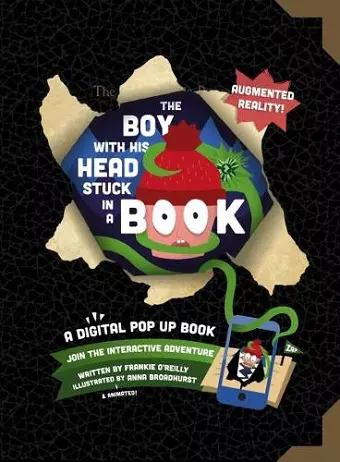The Boy with His Head Stuck in a Book
A Digital Pop-Up Book
Format:Paperback
Publisher:Newcastle Libraries & Information Service
Published:28th Apr '17
Should be back in stock very soon

The story is packed with intertextuality. The protagonist, a primary school aged boy with whom our target audience can readily identify with, literally gets his head stuck in a book when he is dragged to a library and is flung into a fantastical world full of characters from classic novels to contemporary fiction. The intent behind referencing a multitude of various renowned books -and snapshots of their narrative climaxes- was to inspire the reader to read widely and realise, like the main character, that there are a plethora of books which will capture their interest and imagination. For teachers and parents, it also provides a quick and easy hook into all the referenced texts: * The Hobbit - J.R.R. Tolkien* Alice in Wonderland - Lewis Carroll* Red Riding Hood - Brothers Grimm* The Wind in the Willows - Kenneth Grahame* The Iron Man - Ted Hughes* Peter Pan - J. M.Barrie* Treasure Island - Robert Louis Stevenson* Sherlock Holmes - Arthur Conan Doyle* A Christmas Carol - Charles Dickens* Oliver Twist - Charles Dickens* Tarzan of the Apes - Edgar Rice Burroughs* King Kong - Merian C. Cooper / Delos W. Lovelace* The Jungle Book - Rudyard Kipling* Jurassic Park - Michael Crichton* The Sword in the Stone - T. H. White* Harry Potter - J.K RowlingBecause there are so many texts and genres referenced, the book could easily be a starting point for at least a term's worth of reading lessons and teachers can be child-led in terms of which character, book or author to research and read next.
A fantastic poetry book - viewed through a smartphone, tablet or iPad the pages come alive like a modern pop-up book!A book to inspire a love of books! An ordinary boy is dragged to the library one mundane Saturday afternoon, much to his dismay; there are a million other things he'd rather be doing! Glumly traipsing up and down the aisles, he comes across an ancient, mysterious book with a mind of its own, and when his head becomes trapped within the pages, he is catapulted into a magical world filled with dinosaurs, dragons, pirates and ghosts...
The possibilities for the classroom are endless: children could write an information text about their favourite dinosaur; investigate what life was like for children in Victorian times; design a pirate antagonist; write spells or create recipes for magic potions; research the habitat of animals in the jungle; or create author biographies. Better still, as the texts aren't referenced explicitly, children can work together to identify the books from which all the characters originate and could be tasked to find these books in their local library.The National Curriculum encourages teachers to make use of library services to support the teaching of reading and writing.English Curriculum Links:The National Curriculum for Key Stage 2 English clearly states that children should be taught to:* read books that are structured in different ways, read for pleasure and maintain positive attitudes to reading - augmented reality reading is key to inspire disengaged pupils to read for pleasure.* increase their familiarity with a wide range of books, including fairy stories, myths and legends, traditional stories, modern fiction, fiction from our literary heritage, and books from other cultures and traditions - 'Head in a Book' introduces fifteen famous texts in an interactive way which children can then go on to explore in more depth.* enjoy and understand language, especially vocabulary, to support their reading and writing. Pupils' knowledge of language, gained from stories, plays, poetry, non-fiction and textbooks, will support their increasing fluency as readers, their facility as writers, and their comprehension - 'Head in a Book' has the capacity to expand pupils' vocabulary.Children can investigate words unfamiliar to them and be encouraged to use dictionaries or deduce their meaning based on contextual clues. Just some of the vocabulary worthy of clarification may be: engulfed, commotion, emerged, listed, mutiny, vast, spectre, stealthily, beacons, vain, poised, underlings, tomes, dislodging, and underling.* make comparisons within and across books - 'Head in a Book' references a multitude of various texts which children can go on to compare and contrast.* read and discuss an increasingly wide range of fiction and poetry and recognise different forms of poetry...prepare poems to read aloud and perform --- 'Head in a Book' is a narrative poem and its rhythmic structure makes it an ideal text to perform or read aloud.* discuss and evaluate how authors use language, including figurative language, considering the impact on the reader - 'Head in a Book' facilitates the teaching of figurative language through usage of idioms, analogy, imagery, similes and metaphors.* 'Head in a Book' can also be used in the explicit teaching of grammar and punctuation: using commas to clarify meaning or avoid ambiguity in writing; using hyphens to avoid ambiguity; using brackets, dashes or commas to indicate parenthesis; and using semi-colons, colons or dashes to mark boundaries between independent clauses.
ISBN: 9780993195624
Dimensions: unknown
Weight: unknown
28 pages